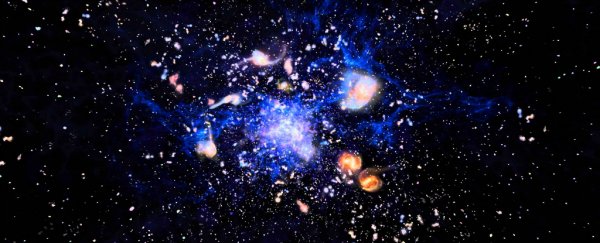Astronomers have observed the birth of one of the most massive objects in our Universe - a huge galaxy cluster known as the Spiderweb Galaxy - and they've shown that it formed in a totally different way than we expected.
Until now, we've observed galaxies getting to these mammoth sizes by swallowing other, smaller galaxies. But the study suggests that more than 10 billion years ago, the Spiderweb galaxy was growing by slurping up a soup of cold molecular gas.
"This is different from what we see in the nearby Universe, where galaxies in clusters grow by cannibalising other galaxies," said lead researcher Bjorn Emonts from the Centre for Astrobiology in Spain.
"In this cluster, a giant galaxy is growing by feeding on the soup of cold gas in which it is submerged."
Based on what we see happening in the close Universe around us, we'd always assumed that massive galaxies and 'supergalaxies' - clusters of thousands of millions of galaxies - formed from smaller galaxies that moved closer and closer together, until they eventually merged due to gravitational attraction.
But this doesn't really make sense in the earliest days of the Universe, when there were barely enough stars and baby galaxies to go around.
"Extremely massive galaxies are seen in the young Universe, but their presence is puzzling because we do not yet understand how they became so massive so quickly," Nina Hatch, an astronomer at the University of Nottingham in the UK, who wasn't involved in the study, wrote in a Perspectives piece accompanying the new paper.
"How do they get enough fuel to form stars so rapidly?"
To figure out what happened back then, the team observed the distant Spiderweb Galaxy, which isn't actually a single galaxy, but instead a cluster of baby protogalaxies that's 10.6 million light-years away from Earth.
This means that when we observe the Spiderweb galaxy now, we're seeing how it was forming back when the Universe was less than 4 billion years old.
Based on what we know of supergalaxy formation today, the team thought they would see stars and small galaxies forming from hydrogen gas, which is standard, and then these galaxies would be drawn together through gravity to make larger galaxies.
But instead what they found suggests that the huge Spiderweb Galaxy just condensed directly from the cloud of gas.
Hydrogen gas is pretty hard to observe directly, so instead the team detected the presence of carbon monoxide (CO) gas in the distant galaxy, which indicates the presence of hydrogen.
Based on the CO observations, the team calculates that, instead of depleting, the hydrogen cloud was huge.
It had a mass around 100 thousand million times the mass of the Sun, and a diameter about three times the size of the Milky Way - which is way more than they'd expected if smaller galaxies were using up all the hydrogen.
The team also found that the gas was unexpectedly cold, about –200 degrees Celsius.
"It is surprising," said one of the research team Matthew Lehnert, from the Astrophysics Institute of Paris. "We would have expected a lot of collapsing galaxies, which would have heated the gas, and for that reason we thought that the carbon monoxide would be much more difficult to detect."
On the contrary, the carbon monoxide was plentiful. And it wasn't actually found inside the smaller galaxies either - it was spread out between the galaxies, which suggests it was being directly sucked up by the supergalaxy.
You can see an artist's impression of this below:

Understanding how these supergalaxies are born is important because they contain some of the most massive galaxies in our Universe, and help us understand why our Universe looks the way it does.
"Spiderweb is an astonishing laboratory, which lets us witness the birth of supergalaxies in the interiors of clusters, which are the 'cosmic cities' of the Universe," said one of the team, George Miley from the University of Leiden in the Netherlands.
"We are beginning to understand how these giant objects formed from the ocean of gas which surrounds them."
Although this is an exciting first step, the team now needs to figure out where the carbon monoxide comes from in the first place.
"It is a byproduct of stellar interiors, but we are not sure where it came from, or how it accumulated in the centre of this cluster of galaxies," said Emonts. "To know this we will have to look even further back into the history of the Universe."
The research has been published in Science.
